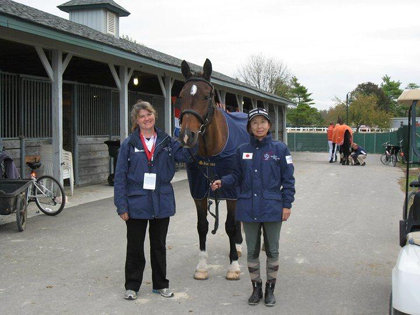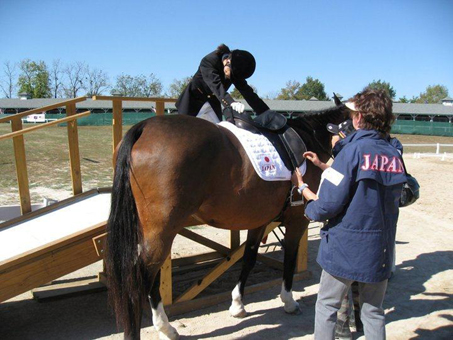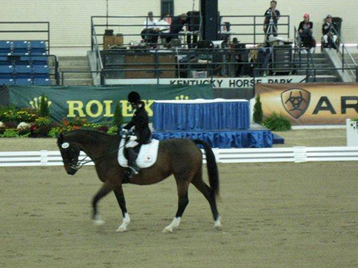|
The
World Equestrian Games in Kentucky included para-equestrian
dressage for the first time as a part of the regular
schedule of the Games. It has been a part of the
Olympics for several cycles, but always as part of the
para-Olympics held after the regular Games. So this was
a first, providing a showcase for the fabulous skills of
these challenged riders and their world-class horses.
Some
countries have riders who either do not own their own
horses or cannot afford to transport them to
international competitions. These riders rely on
borrowed horses to compete, a real disadvantage against
the riders on their own mounts. When the call went out
for horses to be made available to borrow, I listed
several of my retired show horses, which now serve as
schoolmasters for my students. In the end, two of mine
were selected for the Japanese Team, and one of my
student's horses selected for the Argentine Team.
Stories about our experiences will be posted in weeks to
come, along with lots of pictures.
GLANZEND AND MINA CHINJIU
A
star of the show was Glanzend. After each of her
performances people from many countries sought me out to
comment on how well she worked with her rider.
The
20 year old Hanoverian mare is a very special horse.
She is a product of my breeding program.
|

Jenny Schwandt,
who raised, trained, and showed
Glanzend for many years, was her groom at
WEG.
She and Mina's coach made a great team.
|
A
student of mine, Jenny Schwandt, bought her as a foal, raised
and trained and showed her with good success through
third level, then traded her in on a younger model a few
years ago.
Since then, the mare has enjoyed teaching countless
riders and is my most versatile school horse. She seems
to enjoy active retirement, but gives nothing away for
free. She will often have a big smile on her face as
she trots at great speed, refusing to canter for a
rider
whose aids are not correct enough. She flings her head
about for entire lessons for riders whose hands donít
follow correctly or are too stiff. She is a great
schoolmaster, but often a frustrating one for riders.
And you risk life and limb if you try to enter her stall
while she is eating! She only warms up to people when
they have treats in hand.
Mina
Chinjiu came to my stable from Japan last April to find
a horse to borrow for WEG. Each para rider is placed in
a Grade, from 1a to 4, depending on the degree of their
physical challenges.
Mina was a 1a, having the most severe disabilities.
Several horses acted confused by the highly active,
often abrupt aids she gives as a result of her cerebral
palsy. Those horses shut down, staying safe, but not
responding well. Mina was on Glanzend for only about 15
seconds, when the mare said, "I like you. What do you
want me to do?"
Three days later, after going through the Grade 1a Team
and Individual tests
quite successfully, we tried out movements to use for
the freestyle. Mina has little control over where her
legs and arms go. When we tried a leg yield at the
walk, she turned herself almost inside out to try to
tell the horse what to do. It was a most bizarre
looking set of aids, certainly nothing Glanzend had
ever experienced. However, on the second try, the mare
calmly stepped

Mina mounts Glanzend from a ramp built
specially for the
WEG Para Dressage warm-up ring at the
Kentucky Horse Park.
|
sideways from centerline to the track.
That truly brought tears to my eyes. The match was
made.
We
worked for 5 months to help our school horse to look
like a horse we could be proud of in an international
arena -- special products used weekly to grow her tail,
extra grooming, lunging several times a week in a way to
build the right dressage muscles over her topline, then
hard work in the 3rd level exercises for the last months
before the Games to build more muscle and fitness.
Meanwhile, Glanzend continued work in the school, but
only with the riders who would not un-do our building
work with their learning process.
Mina
has competed in several world class competition for para
dressage riders, always on borrowed horses. She
competed at the Athens Olympics, and qualified for
Beijing (Hong Kong), but couldn't find a horse to
borrow. The Japanese contingent felt Glanzend was the
best horse ever made available to her. Mina's dream was
to get a 64%, and the whole group erupted with joy when
her score of 64% for the Team Test was announced.
Reading over her test sheets carefully, Mina realized
that the main thing lacking for an even higher score was
activity in the walk. Accuracy, bend, connection, and
other dressage basics were all in place. A fierce
competitor, Mina telegraphed her determination to
Glanzend when it was time for the Individual Test. The
mare responded by sharpening her reactions to the aids
and adding energy from the start. Unfortunately, extra
effort with Mina's legs to go forward after the first
halt at X was accompanied by extra movement of her
arms.....cerebral palsy creates a severe challenge in
developing independence of the aids. Glanzend
interpreted this as a signal to rein back. Her
obedient steps brought low scores from the judges.
More inadvertent aids created an unscheduled halt in the
third movement of the test. I could see Mina keep
her cool, re-group, decide that trying too hard was
causing problems. She then proceeded with a less
vigorous set of aids. The remainder of the test
was lovely, active, correct and earned higher scores
than her Team Test.

Mina and
Glanzend on the centerline, totally focused.
|
Only the two mis-communications, bringing 4s from most
of the judges, kept her score on the same 64%.
Horse and rider were ready for the freestyle. It's hard
to create an interesting freestyle with only walk to
use. Mina managed to include a high degree of
difficulty with a movement we had never practiced on the
horse: E turn left across the arena, make a figure 8
with two 8 meter circles on the quarter line, pass
through X and make a second figure 8 on the next quarter
line, then turn right at B. Having judged many
freestyles over the years where I was very puzzled as to
what the rider was trying to do, I was praying that this
exercise wouldn't turn into an unrecognizable muddle.
They performed it perfectly, with clear changes of bend,
always on the bit. The free walk had good stretch,
activity, and overtrack, which is quite a trick for
Mina, because she cannot lengthen the reins. She has to
lean as far forward as she can to give the horse a way
to stretch, the legs swinging back onto the horse's
flanks. The judges liked it a lot, and they earned
almost 67%. Mina was over the moon with the score, and
with her satisfaction in their performance together.
Her coach was ready to try to squeeze Glanzend into her
suitcase for the trip back to Japan!
What I had never realized is that most of the horses
used by para-equestrians in competitions at this level
have gaits that would be considered world class in any
setting. If they only walk, like for Grade 1a, a winner
will surely have a walk that would earn a 9 in any
company. None of the medal winners in any grade had
gaits that any judge could give less than an 8.
Glanzend's walk is a strong and consistant 7, but not in
the league of the winners. If a horse had any gait that
was even slightly irregular, such as a slightly lateral
walk, it was far down in the standings. The Grade 3
and 4 tests, which are the equivalent of our Third and
Fourth Levels, were performed well enough to win USDF
Horse of the Year Awards. The United States and Canada
had very capable riders, but were badly outclassed by
the quality of horses from other countries. I thought I
would see many older, retired show horses like the two
I brought. Not so! These horses were in their prime,
typically from 7 to 14 years old, and in top competitive
condition. The warm-up ring was often full of eye candy
for the dressage lover!
It
was an honor to be able to have three horses from my
stable compete at the World Equestrian Games. My
students and I worked very hard to prepare them and to
keep them happy, healthy, and fit while at the
games.....all services donated.
All the time and effort
was worth it, for the joy and sense of accomplishment it
brought to Mina and the other riders.
|